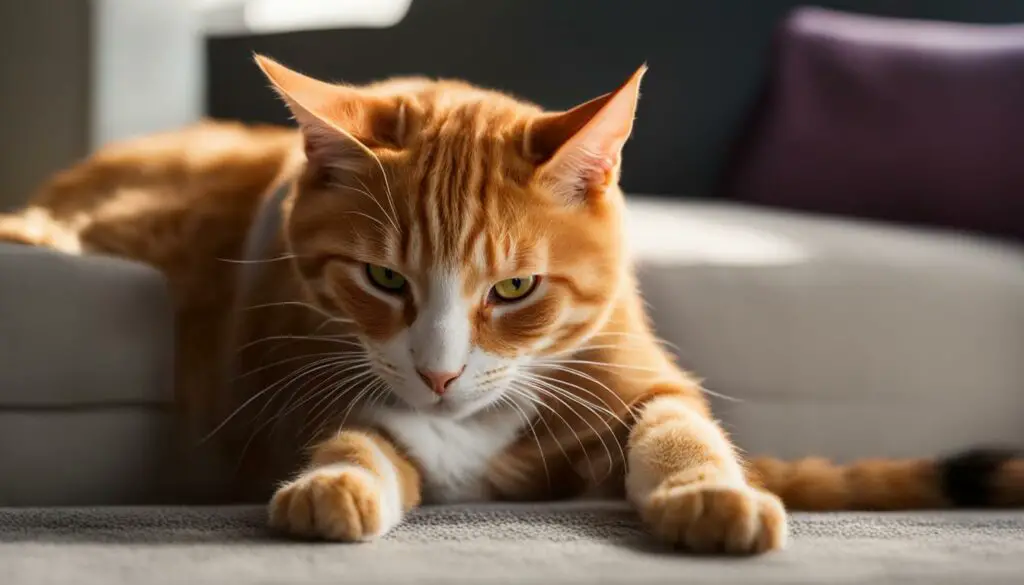Dealing with a cat that keeps taking off its cone can be a challenging situation. As a feline owner, it’s important to understand the significance of cones in your cat’s recovery process. In this ultimate guide, I will provide you with valuable information on the different aspects surrounding cat cones and how to ensure your furry friend’s comfort and well-being during their medical journey.
Key Takeaways:
- A cat cone, also known as an Elizabethan collar or E-collar, is a gadget that prevents cats from licking or biting certain areas of their body.
- Reasons why a cat may need a cone include surgery, wounds, and excessive scratching or grooming.
- Consulting with a veterinarian is essential to determine if a cone is necessary for your cat’s specific situation.
- Types of cat cones include traditional plastic cones, soft cones, fabric cones, and inflatable cones.
- Alternatives to traditional cones include homemade options and protective clothing.
What is a Cat Cone?
A cat cone, also known as an Elizabethan collar or E-collar, is a simple gadget that wraps around a cat’s head to prevent them from licking or biting certain parts of their body. It is commonly referred to as the “cone of shame” or “lampshade.” The cone is available in various types, including store-bought options and homemade alternatives.
Cat cones play a vital role in the post-operative care of cats and can be used during their recovery period. They are typically made of lightweight, durable materials such as plastic or fabric and come in different sizes to fit cats of various breeds and sizes. The cone is designed to create a physical barrier around the cat’s head, preventing them from accessing wounds, incisions, or any other areas that require protection.
“The cone is an essential tool to prevent cats from causing harm to themselves and impeding the healing process,” says Dr. Emily Johnson, a veterinarian at Paws and Whiskers Veterinary Clinic. “It may seem uncomfortable or restrictive to the cat, but it serves the purpose of ensuring their safety and promoting a successful recovery.”
While the cone of shame is the most common type of cat cone, there are also alternatives available. Soft fabric cones or inflatable cones, for example, offer a more comfortable and less restrictive option for cats. Homemade cone alternatives, such as using paper plates or protective shirts, can also be effective in some cases. The choice of cone depends on the cat’s specific needs and comfort level.
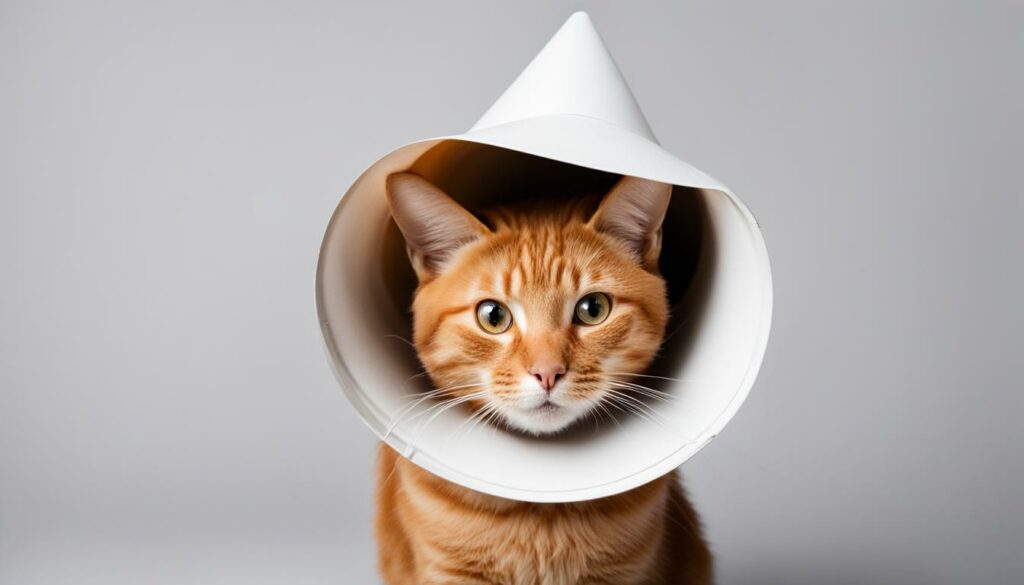
Types of Cat Cones:
| Type | Description |
|---|---|
| Traditional Plastic Cone | A cone made of rigid plastic that forms a full circle around the cat’s head. It provides effective protection but may be less comfortable for the cat. |
| Soft Cone | Made of foam and fabric, these cones offer a more comfortable and flexible alternative to traditional plastic cones. |
| Fabric Cone | A cone made entirely of soft fabric, such as cotton or fleece. It is lightweight and allows for better mobility. |
| Inflatable Cone | An inflatable cone that provides a balance between protection and comfort. It can be easily adjusted to fit the cat’s neck size. |
Why Would Your Cat Need a Cone?
Cats may require the use of a cone, also known as an Elizabethan collar or E-collar, in various situations. The most common reason is after surgery, to prevent them from licking or biting their incisions or stitches. By wearing a cone, the cat’s surgical site is protected, reducing the risk of infection and promoting proper healing.
In addition to surgery, cats may need a cone to prevent excessive grooming or scratching. Some cats may have allergies or skin conditions that cause them to excessively lick or scratch certain areas, leading to further irritation or injury. The cone acts as a physical barrier, preventing the cat from reaching those areas and allowing them to heal.
It’s important to follow veterinary advice when determining if a cone is necessary for your cat. Your vet will assess the specific situation and provide guidance on whether a cone is required and for how long it should be worn. They may also suggest alternative options if a cone is not suitable for your cat’s needs.
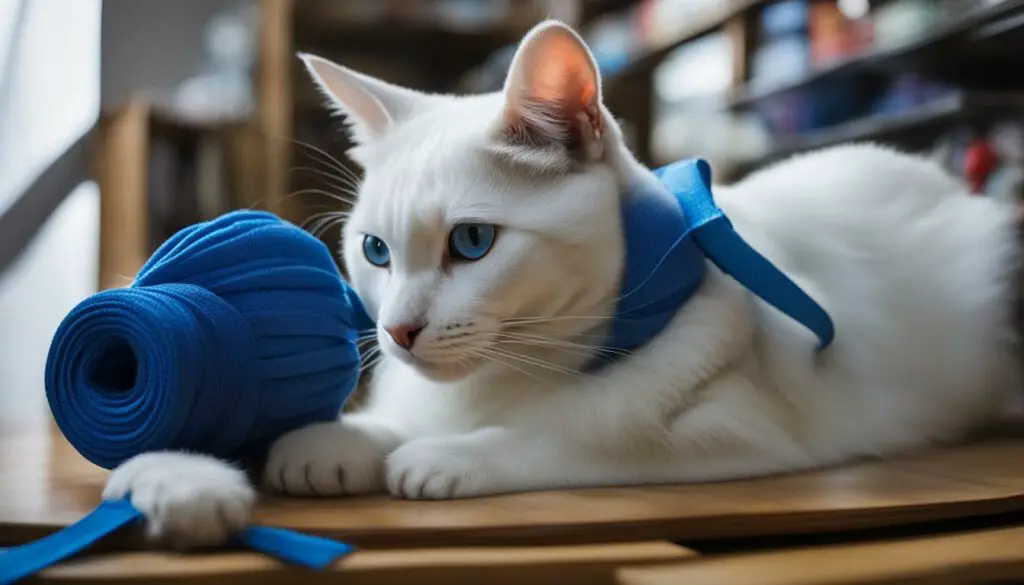
Situations where a cat may need a cone:
- Post-surgery to protect incisions and stitches
- To prevent excessive grooming or scratching of irritated areas
Wearing a cone can be an adjustment for cats, but it is an essential tool in ensuring their well-being during the recovery process.
| Pros | Cons |
|---|---|
| Provides physical barrier for protection | May cause temporary discomfort or stress |
| Prevents infection and promotes healing | May interfere with eating, drinking, and grooming |
Does My Cat Really Need a Cone?
When it comes to the decision of whether or not your cat needs a cone, it is important to consider a few key factors. While cones are often recommended by veterinarians after surgeries or procedures, they may not always be necessary. In some cases, cats can successfully recover without a cone as long as they do not bite or tug at their stitches.
To determine if a cone is necessary for your cat, it is best to consult with your veterinarian. They will be able to assess your cat’s specific situation and provide a recommendation based on their professional expertise. In cases where the surgical site is in an easily accessible area or your cat is known to be particularly prone to licking or scratching, a cone may be strongly advised to prevent complications.
It is important to remember that the temporary use of a cone is meant to aid in your cat’s healing process. While it may seem uncomfortable or restrictive to your cat, their well-being and recovery should always be the priority. If a cone is recommended, make sure to follow the veterinary advice regarding the appropriate type and fit for your cat to ensure their comfort and safety.
Additional Considerations
While a cone may be necessary in some cases, there are alternative options available that can provide similar benefits. For example, some cats may be more comfortable wearing a soft cone made of foam or fabric rather than the traditional plastic cone. Homemade options, such as protective shirts or onesies, can also be used to restrict access to the surgical site.
Ultimately, the decision to use a cone or explore alternative options should be made in consultation with your veterinarian. They will be able to provide guidance based on your cat’s individual needs and circumstances. Remember, the well-being and comfort of your cat should always be the top priority during their recovery process.
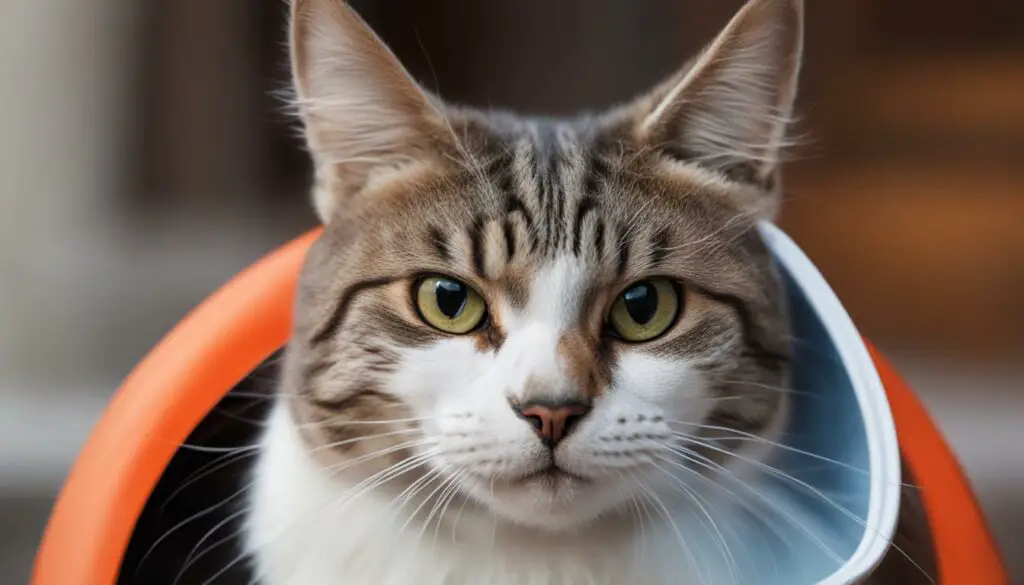
| Pros of Using a Cone | Cons of Using a Cone |
|---|---|
| Provides physical barrier to prevent licking or biting of stitches | May cause temporary discomfort or restriction for the cat |
| Reduces the risk of infection or complications from excessive grooming | Some cats may struggle to eat, drink, or move comfortably with the cone on |
| Allows the surgical site to heal properly without interference | Can potentially cause temporary behavioral changes or signs of distress in some cats |
Types of Cat Cones & Alternatives
When it comes to cat cones, there are various options available to suit your cat’s specific needs. In addition to the traditional plastic cone, there are also soft cones, fabric cones, inflatable cones, and even homemade alternatives.
The traditional plastic cone, also known as an Elizabethan collar, is the most commonly used type. It provides a rigid barrier around your cat’s head, preventing them from reaching areas they should not lick or bite. However, some cats find the plastic cone uncomfortable or restrictive.
For cats that need a more comfortable option, soft cones made of foam and fabric are a great alternative. These cones provide a more flexible and less intrusive option while still effectively preventing your cat from accessing their wounds. Additionally, fabric cones are lightweight and allow for better visibility, while inflatable cones are adjustable and can be deflated for easy storage.
If you prefer a DIY approach, homemade options can also be effective. Using items such as paper plates or protective shirts, you can create a custom cone that fits your cat’s needs. However, it’s important to ensure that any homemade cone provides enough protection and does not restrict your cat’s movement or breathing.
| Type of Cone | Description |
|---|---|
| Traditional Plastic Cone | The most common type, provides a rigid barrier. |
| Soft Cone | Made of foam and fabric, offers a more comfortable option. |
| Fabric Cone | Lightweight and allows for better visibility. |
| Inflatable Cone | Adjustable and can be deflated for easy storage. |
| Homemade Options | DIY alternatives using items like paper plates or protective shirts. |
Ultimately, the type of cone you choose for your cat will depend on their specific needs, comfort levels, and the recommendation of your veterinarian. It’s important to find the option that best suits your cat’s individual circumstances to ensure a smooth and comfortable recovery process.
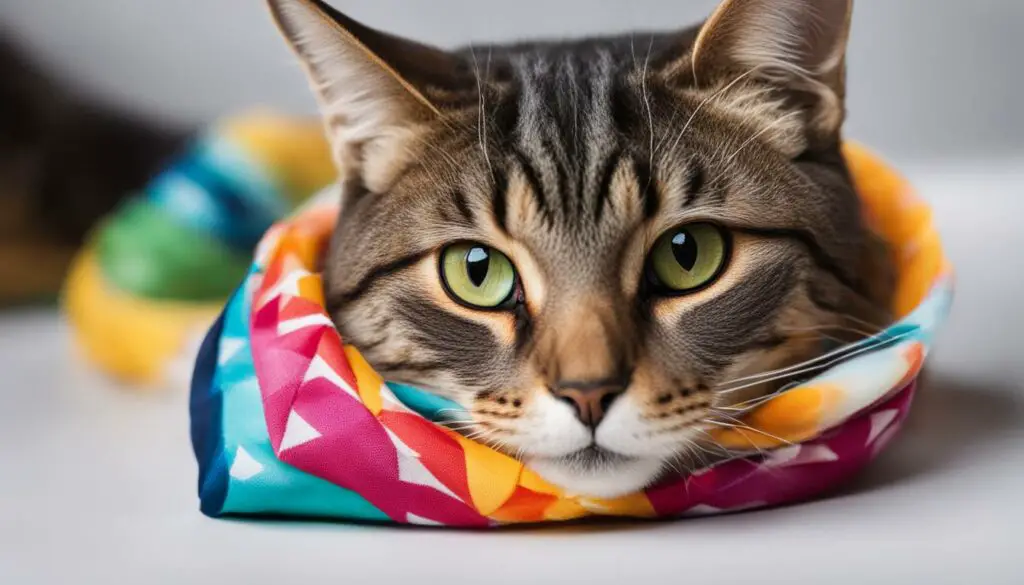
What to Expect when Your Cat Wears a Cone
When your cat first wears a cone, it may take some time for them to adjust. During this adjustment period, you may notice that your cat struggles to walk or bumps into objects. This temporary discomfort is normal as your cat learns to navigate with the cone. However, with time, most cats adapt and become more comfortable moving around.
During the adjustment period, it’s crucial to provide close supervision to ensure that the cone is properly fitted and doing its job. Keep an eye out for any blocked areas or situations where your cat may get stuck. Remember, the cone is meant to prevent licking or biting at certain areas, so any attempts to reach those areas should be restricted.
Table 6.1: Tips for CAT cone adjustment period
| Tip | Description |
|---|---|
| Provide a calm environment | Help your cat feel relaxed and secure by creating a quiet and comfortable space. |
| Clear blocked areas | Remove any obstacles or furniture that may hinder your cat’s movement. |
| Offer encouragement and rewards | Use positive reinforcement, such as treats or praise, to help your cat associate the cone with positive experiences. |
| Monitor for signs of distress | Keep an eye out for excessive pawing at the cone, signs of discomfort, or any abnormal behavior. |
Walking with the Cone
While walking may be challenging initially, most cats adapt quickly and regain their balance. Encourage your cat to take short walks and gradually increase the duration as they become more comfortable. Offer support and guidance, especially during the initial stages, to help your cat navigate obstacles without getting stuck or injured.
Supervision and Safety
During the adjustment period, it’s important to supervise your cat closely to ensure their safety. Be vigilant for any signs of distress or attempts to remove the cone. If you notice excessive pawing or attempts to remove the cone, consult with your veterinarian for further guidance or potential alternatives.
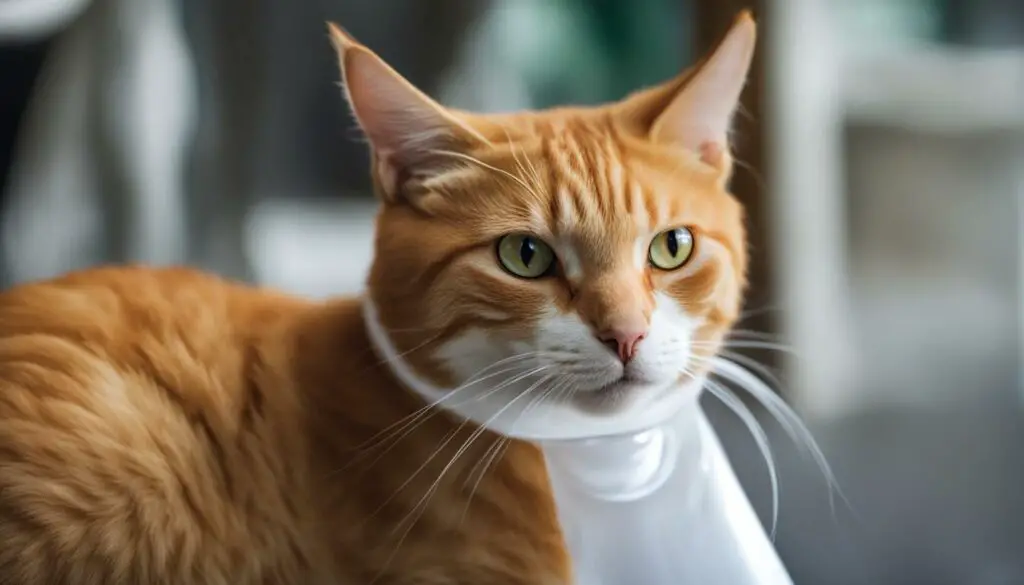
By providing the necessary support, monitoring their progress, and ensuring a safe environment, you can help your cat adjust to wearing a cone and support their recovery process.
How Will My Cat Eat and Drink with a Cone On?
One of the challenges of having a cat wear a cone is ensuring they can still eat and drink comfortably. The cone can make it difficult for them to access their food and water bowls, leading to frustration and potential dehydration or malnutrition. However, with a few adjustments and some extra care, you can help your cat continue to eat and drink while wearing a cone.
One way to facilitate eating and drinking is by raising their bowls. Elevated bowls can make it easier for cats to reach their food and water without having to tilt their heads too much. You can use a sturdy platform or even stack books or other objects to achieve the desired height. Make sure the setup is stable and secure to prevent any accidents.
Another option is to trim the cone slightly to allow your cat better access to their bowls. Be cautious when doing this and only remove a small portion at a time. It’s essential to maintain the overall integrity and effectiveness of the cone in preventing your cat from reaching their surgical site or wound.
In some cases, temporary removal of the cone may be necessary to allow your cat to eat and drink more comfortably. However, this should be done under supervision, and the cone should be promptly put back on once your cat has finished eating. Do not leave your cat without the cone for an extended period as it defeats the purpose of their recovery and protection.
| Adjustments for Eating and Drinking with a Cone On: |
|---|
| Raise their food and water bowls to a comfortable height. |
| Trim the cone slightly to improve access. |
| Temporarily remove the cone under supervision for eating and drinking, then promptly put it back on. |
Remember, the main objective is to ensure your cat’s well-being and recovery. By making these adjustments and closely monitoring their eating and drinking habits, you can help alleviate any potential discomfort and ensure they receive proper nutrition during their healing process.
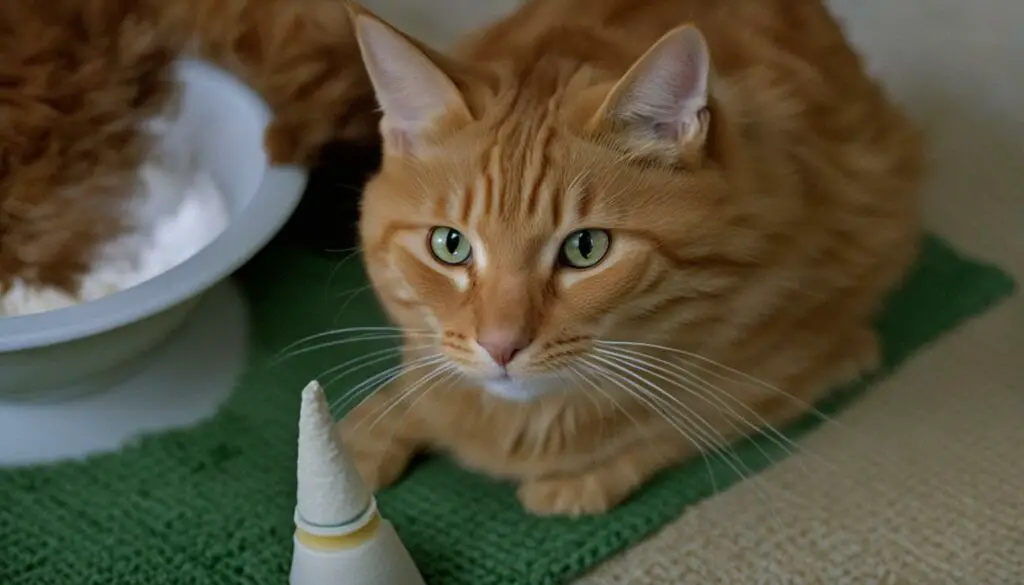
How Will My Cat Stay Groomed with the Cone On?
Grooming is an essential part of a cat’s routine and helps maintain their coat’s health and cleanliness. However, wearing a cone can make it challenging for cats to groom themselves effectively. Here are some tips to assist your cat in staying groomed while wearing a cone:
- Regular Brushing: Brushing your cat’s fur can help prevent matting and keep their coat in good condition. Gently brush around the cone, avoiding the surgical site, to provide some stimulation and maintain their grooming habits.
- Grooming Assistance: Some areas may be difficult for your cat to reach with the cone on. You can assist them by gently scratching around the cone without putting pressure on the surgical site. This can provide some relief and help them reach those itchy spots.

Remember, grooming difficulties are temporary, and your cat will be able to resume their regular grooming routine once they have recovered from their condition or surgery. It is important to keep an eye on your cat’s grooming habits to ensure their coat remains in good condition.
Common Grooming Challenges with a Cone
While wearing a cone, your cat may face some grooming challenges such as:
- Difficulty reaching certain parts of their body
- Inability to lick or groom themselves effectively
- Potential discomfort or frustration
Regular brushing and gentle grooming assistance can help your cat stay groomed and comfortable during this period.
By providing grooming assistance and monitoring their coat’s condition, you can help your cat feel more comfortable during their recovery and ensure their grooming needs are met.
Do Cones Make Cats Depressed?
Wearing a cone can be a source of discomfort for cats, and in some cases, it may lead to temporary behavioral changes and signs of depression. It’s important to monitor your cat closely during this time and provide any necessary support or alternatives to alleviate their distress.
Some cats may exhibit changes in eating habits, reduced playfulness, or a lack of interaction with their environment while wearing a cone. These behaviors can be a result of the physical discomfort caused by the cone or the restriction it imposes on their natural behaviors.
“Cats may experience temporary behavioral changes and signs of distress when wearing a cone. It’s crucial to provide them with additional support and seek alternative options if necessary.”
If you notice that your cat is displaying signs of distress, it’s important to consult with your veterinarian. They can provide guidance on how to make your cat more comfortable or explore alternative options that may better suit their needs. Remember, your cat’s well-being and mental health should be a priority during their recovery process.
While cones are often necessary to prevent cats from interfering with their wounds or surgical sites, it’s essential to provide them with the necessary care and attention to minimize any potential negative effects on their behavior and overall well-being.
My Cat Won’t Sleep with Cone On, What Should I Do?
If your cat is having difficulty sleeping with a cone on, it may be due to discomfort or the unfamiliar sensation. It’s essential to prioritize your cat’s comfort during sleep to ensure proper rest and healing. Here are a few alternatives you can consider:
1. Protective Shirt:
A protective shirt can be a great alternative to a cone. These shirts are specifically designed to cover the surgical site while allowing your cat to move freely and sleep comfortably. They provide a less restrictive option and can help prevent your cat from licking or biting the area.
2. Soft Cone:
If your cat finds the traditional plastic cone uncomfortable, you can try a soft cone made of foam or fabric. These cones are more flexible and can provide a more comfortable fit for your cat, allowing them to sleep more easily. They still serve the purpose of preventing your cat from accessing the surgical site.
3. Comfortable Cone Design:
If you prefer to stick with a traditional cone, look for ones with added features for comfort. Some cones have padding on the edges or adjustable straps to provide a better fit. Additionally, cones with clear panels can help reduce disorientation and make it easier for your cat to sleep.
Remember, it may take some trial and error to find the best alternative that suits your cat’s needs. It’s important to consult with your veterinarian for recommendations and guidance to ensure you choose the right option for your cat’s specific situation.
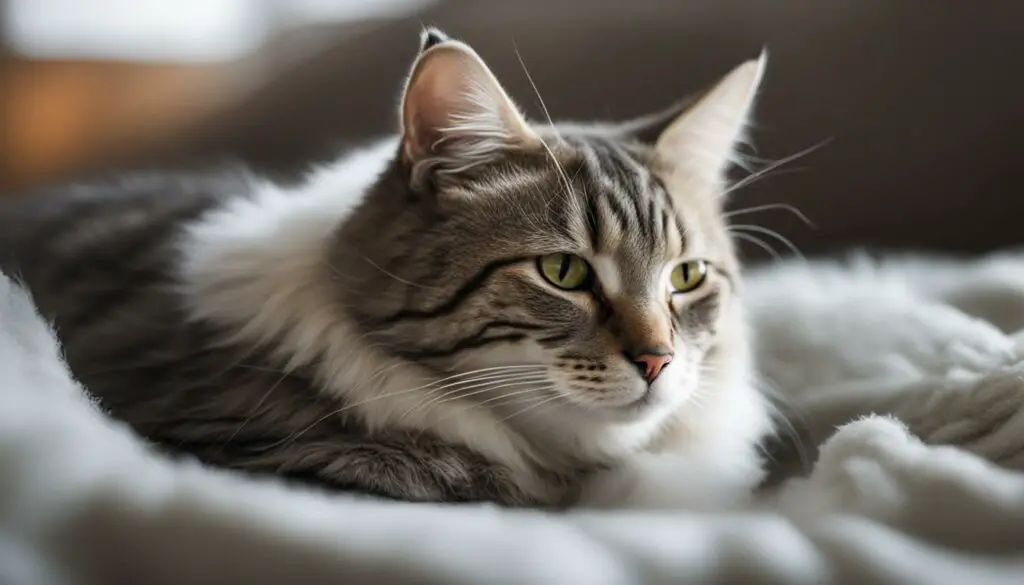
Disclaimer: The information provided in this article is not a substitute for professional veterinary advice. Always consult with a veterinarian for proper diagnosis and treatment of your cat’s specific condition.
Male Cat Licking After Neutering
After neutering, male cats may experience the urge to lick or scratch the surgical site. This behavior can be driven by inherent instincts or discomfort caused by itching or pain. However, excessive licking can lead to infections or complications that may hinder the healing process. To prevent this, it is essential to take measures to restrict access to the wound and promote proper healing.
Using a cat cone, also known as an Elizabethan collar or E-collar, can be an effective way to prevent your male cat from licking or scratching the surgical site. The cone creates a physical barrier that restricts access to the wound, allowing it to heal without interference. Alternatively, you can explore other methods such as using pet diapers or dressing your cat in baby clothing to provide a similar level of protection.
It is crucial to monitor your male cat closely during the recovery period to ensure that the cone or alternative method is effective in preventing excessive licking. If you notice any signs of infection, such as redness, swelling, or discharge, it is important to consult your veterinarian for appropriate treatment. By taking proactive measures to address excessive licking, you can help facilitate a smooth recovery process for your male cat after neutering.
Table: Comparison of Methods to Prevent Male Cat Licking After Neutering
| Method | Description | Pros | Cons |
|---|---|---|---|
| Cat Cone | A cone-shaped device that restricts access to the surgical site. | – Provides a physical barrier | – Can cause temporary discomfort |
| Pet Diapers | Diapers designed for cats that cover the genital area. | – Allows for normal movement | – Requires regular changing |
| Baby Clothing | Small-sized baby clothes that cover the surgical site. | – Provides a snug fit | – May require frequent adjustment |
It’s important to note that while these methods can help prevent licking, they should be used under supervision and in consultation with your veterinarian. Your veterinarian can provide specific recommendations based on your cat’s individual needs and ensure that the chosen method is suitable for your cat’s recovery process.
In conclusion, preventing excessive licking after neutering in male cats is crucial for their proper healing and recovery. By using a cat cone or exploring alternative methods, you can effectively restrict access to the surgical site and minimize the risk of complications. Remember to closely monitor your cat during the recovery period and seek veterinary advice if any concerns arise. With proper care, your male cat can heal comfortably and quickly after neutering.
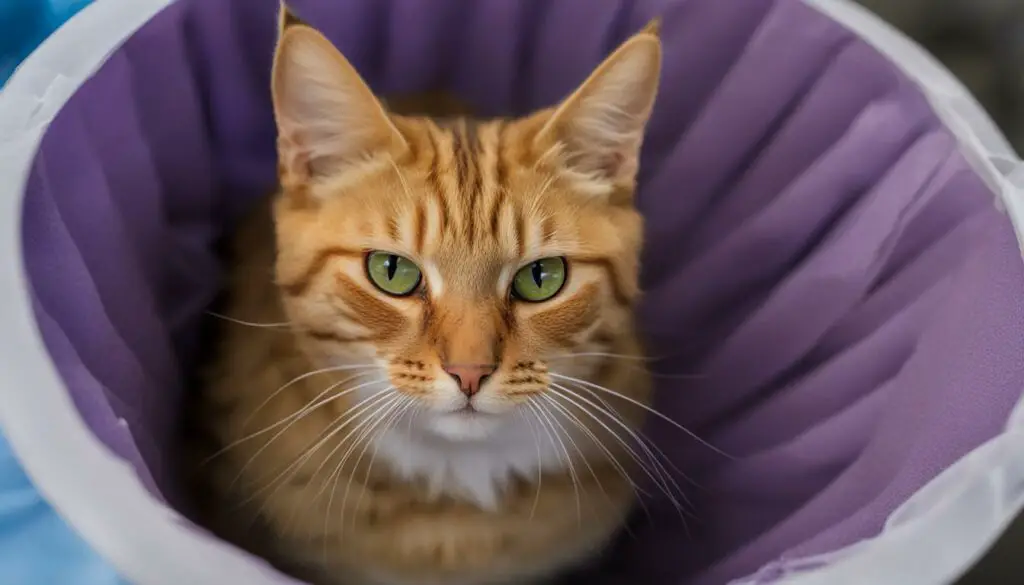
Can I Put Clothes on My Cat Instead of a Cone?
When it comes to finding alternatives to the traditional cat cone, protective clothing, such as clothes designed specifically for cats, can be a viable option. These garments serve the same purpose as a cone by preventing your cat from licking or scratching wounds, while also providing a more comfortable and less restrictive alternative. So, if you’re wondering whether you can put clothes on your cat instead of a cone, the answer is yes!
Protective clothing for cats comes in various forms, including pet recovery suits and small dog sweaters. These garments are specially designed to fit your cat comfortably while restricting access to the wound or surgical site. They can be particularly beneficial for cats who find cones uncomfortable or distressing.
When using clothes as an alternative to the cone, it’s important to ensure that the clothing fits properly and allows for proper ventilation and movement. The fabric should be soft and non-irritating, and the garment should be secure enough to prevent your cat from removing it easily. It’s also crucial to regularly check the clothing for any signs of discomfort or irritation and remove it if necessary. Additionally, always consult with your veterinarian to determine the most suitable alternative for your cat’s specific needs.
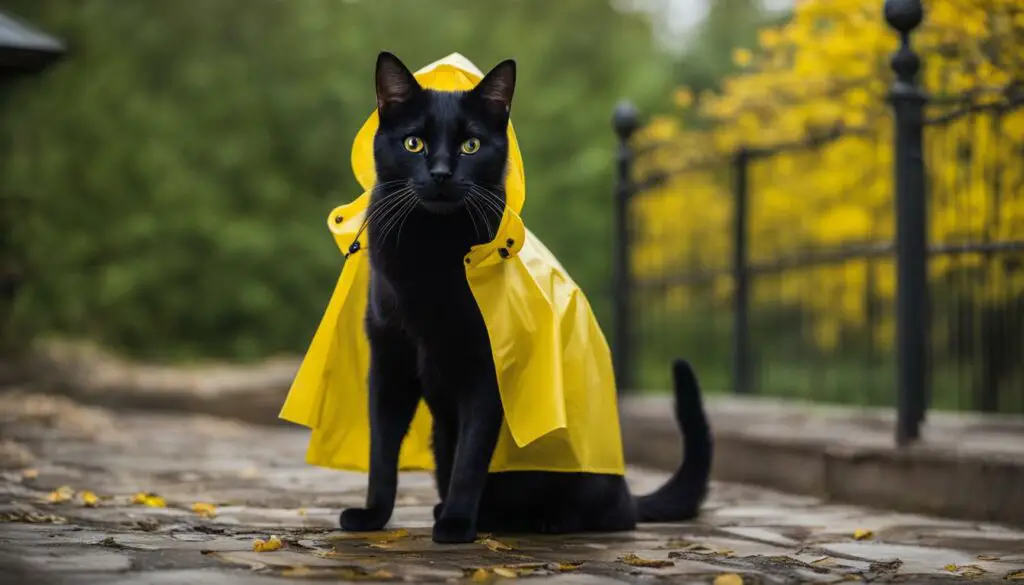
Benefits of Using Clothes as an Alternative
- Comfort: Clothes designed for cats can offer a more comfortable and less restrictive alternative to traditional cones. They allow your cat to move more freely while still protecting the surgical site or wound.
- Reduced Stress: Some cats may find cones distressing or uncomfortable. Using protective clothing can help reduce stress and anxiety during the recovery period.
- Easier Eating and Drinking: Unlike cones, which can make it challenging for cats to eat and drink, clothes do not interfere with their ability to access food and water bowls.
- Improved Mobility: Clothes that fit properly allow your cat to move around more easily, enabling them to engage in their regular activities while still protecting the affected area.
In conclusion, clothes can be a suitable alternative to the traditional cat cone when it comes to protecting wounds or surgical sites. They offer comfort, reduced stress, and improved mobility for your furry friend during the recovery process. Just remember to choose the right size and style of clothing, ensure proper fit and ventilation, and closely monitor your cat’s comfort level and behavior. Your veterinarian can provide additional guidance and recommendations based on your cat’s individual needs.
Conclusion
In this ultimate guide, I have provided you with a comprehensive understanding of how to deal with a cat that keeps taking off its cone. We have discussed the importance of cones, the different types available, and why your cat may need a cone in the first place. Additionally, I have shared alternatives to traditional cones and tips on ensuring your cat’s comfort and recovery during this period.
By following the advice of veterinary professionals and considering your cat’s specific needs, you can provide the necessary support for their medical and behavioral requirements. Remember that a cone is a temporary solution that aids your feline friend’s recovery, and it plays a crucial role in preventing complications and promoting healing.
Throughout this guide, we have explored various aspects of cat cones, including their purpose, usage, and potential alternatives. It is essential to prioritize your cat’s comfort, closely monitor their behavior and adjust as needed. If your cat shows signs of distress or discomfort, consult with your veterinarian to explore alternative options that may better suit their needs.
With the knowledge gained from this ultimate guide, you can confidently navigate the challenges of a cat that keeps taking off its cone. Remember to be patient with your cat during their adjustment period, provide them with the necessary assistance, and always seek professional veterinary advice when in doubt. Your dedication to your cat’s well-being and recovery will go a long way in ensuring a successful and stress-free healing journey.
FAQ
What is a Cat Cone?
A cat cone, also known as an Elizabethan collar or E-collar, is a simple gadget that wraps around a cat’s head to prevent them from licking or biting certain parts of their body. It is commonly referred to as the “cone of shame” or “lampshade.”
Why Would Your Cat Need a Cone?
Cats may need a cone to prevent them from licking or biting surgical incisions or wounds, which can lead to complications such as infections or delayed healing. The cone can also be used to protect the face or other areas where the cat is prone to excessive scratching or grooming.
Does My Cat Really Need a Cone?
While a cone is often recommended by veterinarians after surgeries or procedures, it may not be necessary in all cases. Some cats can recover without a cone as long as they do not bite or tug at their stitches. It is important to consult with a vet to determine if a cone is needed for your cat’s specific situation.
What Types of Cones and Alternatives Are Available?
There are various types of cones available for cats, including traditional plastic cones, soft cones made of foam and fabric, fabric cones, and inflatable cones. Additionally, there are alternatives to traditional cones, such as homemade options using items like paper plates or protective shirts.
What Can I Expect when My Cat Wears a Cone?
Cats may have an adjustment period when they first wear a cone. They may struggle to walk or bump into objects, but with time, most cats adapt and become more comfortable. It is important to closely supervise your cat during this period to ensure the cone is doing its job and that they are not harming themselves or getting stuck in tight spots.
How Will My Cat Eat and Drink with a Cone On?
Some cats may have difficulty eating or drinking with a cone on. You can make adjustments such as raising their bowls or trimming the cone to improve their access. In some cases, you may need to remove the cone temporarily to allow your cat to eat and drink comfortably, but this should be done under supervision.
How Will My Cat Stay Groomed with the Cone On?
Cats may have difficulty grooming themselves with a cone on. Regular brushing can help prevent matting and provide some skin stimulation. You may also need to assist your cat with areas they can’t reach by gently scratching around the cone without putting pressure on the surgical site. Remember that the cone is temporary and grooming will resume after recovery.
Do Cones Make Cats Depressed?
It is possible for cats to feel uncomfortable or restricted while wearing a cone, which can lead to temporary behavioral changes and signs of depression. They may stop eating, playing, or interacting with their environment. Observing these behaviors is important, and if your cat shows signs of distress, consult with your vet to explore alternative options or provide additional support.
My Cat Won’t Sleep with Cone On, What Should I Do?
If your cat is having difficulty sleeping with a cone on, it may be due to discomfort or the unfamiliar sensation. Consider using alternatives such as a protective shirt or finding a softer and more comfortable cone. It is crucial to prioritize your cat’s comfort during sleep to ensure proper rest and healing.
Why does my Male Cat Lick After Neutering?
Male cats may lick or scratch the surgical site after neutering due to inherent instincts or discomfort caused by itching or pain. It is important to prevent excessive licking to avoid potential infections or complications. Using a cone or alternative methods, such as pet diapers or baby clothing, can help restrict access to the wound and promote proper healing.
Can I Put Clothes on My Cat Instead of a Cone?
Yes, you can use clothes as an alternative to a cone. Protective clothing, such as pet recovery suits or small dog sweaters, can provide similar benefits as a cone by preventing licking or scratching of wounds. It is essential to ensure the clothing fits properly and allows for proper ventilation and movement.

